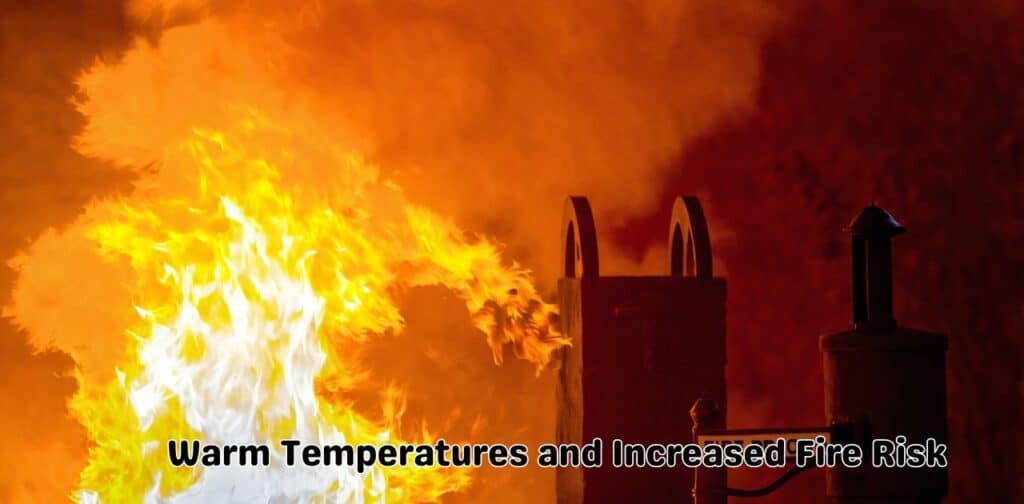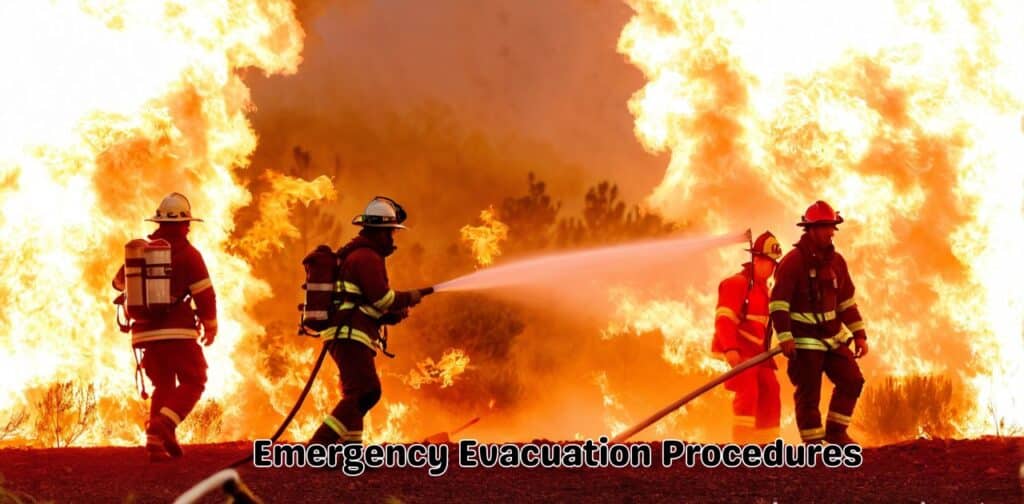Introduction
A medida que las temporadas de incendios forestales se vuelven más intensas y duraderas en los Estados Unidos, comprender las advertencias de bandera roja se ha vuelto crucial para la seguridad pública.
Estas advertencias señalan la tormenta perfecta de factores ambientales que aumentan significativamente la probabilidad y gravedad de los incendios forestales. Desde temperaturas abrasadoras y paisajes áridos hasta ráfagas de viento, las condiciones de bandera roja exigen toda nuestra atención y preparación.
“As wildfire seasons become more intense and prolonged in the United States, understanding red flag warnings has become crucial for public safety. These warnings indicate the perfect storm of environmental factors that significantly increase the likelihood and severity of wildfires. From scorching temperatures and parched landscapes to gusty winds, red flag conditions require our full attention and preparation.”
Climate Change and Wildfire Trends
Climate change is undoubtedly exacerbating the wildfire threat. Rising global temperatures have led to more frequent and prolonged heat waves, creating tinderbox conditions ripe for ignition. In fact, the annual wildfire season is now 78 days longer than it was in the 1970s, according to the Center for Climate and Energy Solutions.
Drought conditions brought on by shifting precipitation patterns have also left vast swaths of the country vulnerable to wildfires. The 2020 wildfire season was one of the most devastating on record, with over 10 million acres burned across the western U.S. alone.
Drought Conditions and Fire Vulnerability
Drought plays a significant role in priming an area for wildfires. As moisture levels in vegetation and soil plummet, these dried-out materials become highly combustible fuel sources. Even the smallest spark can ignite a blaze that quickly rages out of control.
Consider this analogy: A parched forest during a drought is like a haystack in a barn all it takes is a lit match for the entire area to go up in flames. Recent data from the U.S. Drought Monitor revealed that over 40% of the continental U.S. was experiencing drought conditions as of April 2023.
Warm Temperatures and Increased Fire Risk

Soaring temperatures are another key factor contributing to red flag warnings. Hot weather accelerates the drying out of vegetation, increasing its flammability. It also causes wildfires to burn hotter, faster, and with greater intensity.
During the catastrophic Camp Fire in 2018, which devastated the town of Paradise, California, temperatures reached a sweltering 90°F (32°C). These extreme conditions allowed the fire to explode in size within hours, ultimately burning over 150,000 acres.
Low Humidity Levels
Low humidity is like gasoline on the fire when it comes to wildfire behavior. As the air becomes increasingly dry, materials like dead leaves, twigs, and grass become even more susceptible to ignition and rapid combustion.
When humidity levels plummet below 15%, fire experts consider the conditions to be “critically dry.” These extremely arid conditions played a pivotal role in the explosive growth of the 2021 Dixie Fire, which burned nearly 1 million acres across California.
Impact of Strong Winds on Fire Behavior
Strong winds can transform a relatively manageable fire into an uncontrollable inferno. Gusty conditions not only fan the flames, but they can also scatter embers far ahead of the main fire line, igniting new spot fires.
“It was like a blowtorch went through our town,” recalled a resident of the town of Malden, Washington, which was devastated by the 2020 Babb Road Fire fueled by powerful winds.
The infamous “Sundance Fire” in 1967, which inspired the term “red flag warning,” saw winds gusting over 50 mph (80 km/h), rapidly spreading the blaze and trapping firefighters.
What Triggers a Red Flag Warning?
Red flag warnings are issued by the National Weather Service when specific criteria for dangerous fire weather conditions are met, typically involving a combination of:
- Low humidity (often below 15-20%)
- Strong winds (20 mph/32 kph or higher)
- Dry fuel moisture (very dry vegetation and soil)
- Warm temperatures
However, the exact thresholds can vary based on local vegetation, topography, and climate patterns.
If conditions are favorable for potential extreme fire behavior within the next 24 hours, a Red Flag Warning is issued. If the risk extends further out, agencies may first issue a Fire Weather Watch to raise awareness.
Monitoring Red Flag Warnings
Staying informed about red flag warnings is crucial for both personal safety and wildfire preparedness. Here are some key ways to monitor these high-risk advisories:
- Emergency Alert Systems: Enable emergency alerts on your mobile devices and home networks to receive real-time notifications.
- Local News and Radio: Pay close attention to local news broadcasts and weather reports, especially during wildfire seasons.
- Online Resources: Websites like inciweb.nwcg.gov and www.weather.gov provide up-to-date information on red flag warnings and wildfire activity.
- Mobile Apps: Download apps like the FEMA app, which pushes notifications about hazardous weather alerts.
Red Flag Warning Protocol: What to Do
When a red flag warning is issued for your area, taking immediate precautions is essential to reduce wildfire risk:
- Avoid Activities that Could Spark Fires: This includes operating machinery, welding, parking on dry grass, smoking outdoors, and more.
- Prepare for Potential Evacuation: Have an emergency kit and evacuation plan ready, including provisions for pets and family members with special needs.
- Stay Informed: Monitor alerts and be prepared to follow any evacuation orders or safety instructions from local authorities.
Community Preparedness and Collaboration
Mitigating wildfire risk requires a collaborative effort from entire communities. Some key preparedness measures include:
- Creating Defensible Space: Clearing brush and combustible materials from around homes and structures.
- Implementing Warning Systems: Utilizing emergency alert systems, sirens, and other methods to quickly notify residents.
- Partnering with Fire Departments: Coordinating with local fire agencies to develop response plans and evacuation routes.
- Conducting Fire Safety Education: Raising awareness about wildfire risks and prevention measures through community outreach programs.
Firefighter Readiness and Response
When red flag warnings are issued, firefighting agencies kick into high gear to position resources and personnel strategically. Advanced tactics like aerial surveillance, predictive modeling, and real-time weather monitoring are employed to stay ahead of rapidly-evolving fire behavior.
However, battling wind-whipped wildfires during red flag conditions poses immense challenges for firefighters. Shifting winds can suddenly alter a fire’s direction, trapping crews or causing spot fires to ignite far from the main blaze.
Emergency Evacuation Procedures

If a wildfire threatens to encroach on populated areas during red flag conditions, authorities may issue mandatory evacuation orders. It’s crucial to heed these orders promptly to allow firefighters clear access and avoid potentially life-threatening situations.
Before evacuating, follow these steps:
- Review Your Evacuation Plan: Familiarize yourself with multiple exit routes and meeting points.
- Prepare a “Go-Bag”: Pack essential items like medications, important documents, and supplies for several days.
- Protect Your Home: Close windows, vents, doors, and remove combustible materials from around the property.
- Follow Official Instructions: Evacuate immediately and follow designated routes provided by emergency personnel.
Public Safety Measures: Reducing Fire Risk
Beyond heeding red flag warnings, there are proactive measures individuals and communities can take to reduce wildfire risks:
- Fire-Resistant Construction: Using fire-resistant building materials and implementing fire-safe design principles.
- Maintaining Defensible Space: Clearing vegetation, debris, and combustible materials from around homes and structures.
- Limiting Ignition Sources: Restricting activities like machinery operation, outdoor burning, and parking on dry grass during red flag periods.
- Enforcing Restrictions: Implementing fines or penalties for violating fire safety regulations during high-risk conditions.
Environmental Impacts of Wildfires
While wildfires are a natural part of many ecosystems, excessive and severe blazes can have devastating environmental consequences:
- Air Quality: Wildfires release massive amounts of particulate matter and gases, leading to hazardous air pollution and respiratory health issues.
- Water Supply: Erosion and debris flows from burned areas can contaminate water sources and reservoirs.
- Loss of Habitat: Fires can destroy critical habitats for wildlife, potentially leading to population declines or local extinctions.
- Landscape Alteration: Severe fires can leave landscapes vulnerable to invasive species, soil erosion, and other ecological disruptions.
Efforts toward sustainable forest management, including controlled burns and thinning operations, can help mitigate the risk of catastrophic wildfires while maintaining ecological balance.
Conclusion
Red flag warnings are a critical alert system that should never be ignored. As climate change exacerbates the wildfire threat across the United States, understanding and heeding these warnings has become a matter of public safety.
When hot temperaturesx , low humidity, strong winds, and dry vegetation converge, the risk of rapidly spreading and uncontrollable wildfires skyrockets. These dangerous conditions demand a coordinated response from communities, firefighting agencies, and individual preparedness efforts.
By staying informed about red flag warnings, taking proactive measures to reduce fire risks, and having an emergency plan in place, we can better protect our homes, our communities, and our natural landscapes from the devastating impacts of wildfires.
Recommended Posts:
Can You Mix Fabuloso And Bleach?
5 WALMART TINY HOMES TO MAKE YOUR DREAMS A BIG REALITY

Howdy is behind this home blog, sharing personal stories, thoughts, and insights from daily life. I can dedicated to bringing you the latest trends, expert advice, and creative ideas to make your home the sanctuary you’ve always dreamed of. Whether you’re looking for DIY tips, home decor inspiration, home loans, rentals or renovations.







